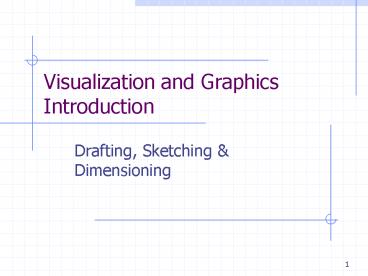Visualization and Graphics Introduction PowerPoint PPT Presentation
1 / 38
Title: Visualization and Graphics Introduction
1
Visualization and Graphics Introduction
- Drafting, Sketching Dimensioning
2
Objectives
- Understanding graphics as a communication tool
- Technical sketching
- Freehand
- Instrument
- Computer
- Projections
- Orthographic
- Pictorial
3
Visualization
- Visualization is often used as a mode of
communication between engineers - Sketches, tables, graphs, computer generated
drawings, blueprints are various ways in which
engineers communicate via visual mediums
4
How Would You Describe This?
- In teams of two, describe using only words
- How effective is this approach?
5
Three Basic Types of Technical Drawings
- Freehand sketches
- Instrument drawings
- Computer drawings
6
Introduction to Projections
- Present 3-D objects with 2-D media
- Two Basic Categories
- Orthographic Pictorial
7
Projections Four Basic Types
Note Isometric is a special case of Axonometric
Axonometric
Pictorials
Oblique
Perspective
8
Types of Axonometrics
9
Pictorial Drawings
- Shows an object like you would see in a
photograph - Give a three dimensional view of a room or
structure - Three common types
- Isometric (Axonometric)
- Oblique
- Perspective
10
Pictorial Sketch of Kitchen
11
Review Questions 1-2
12
Isometric Drawings
- The most common pictorials
- Constructed with the two faces 30 degrees above
the horizontal - The axes are 120 degrees between each axis
- Lines that are horizontal are drawn at 30 degrees
- Vertical lines remain vertical
13
Isometric Projection
?CUBE?
- Isometric means equal measure
- All planes are equally or proportionately
shortened and tilted - All the major axes (X, Y, Z) are 120 degrees
apart
14
- Making an Isometric Sketch
- Defining Axis
15
Isometric of a Cube
16
Isometric Dimensioning
- Dimension lines are parallel to the isometric
axes - Extension lines are extended in line with these
axes
17
Oblique Drawings
- The front view is draw like it would be using
orthographic projection - The front view shows all features with true shape
and size - The top and side view are then projected back
from the front view - Views can be at any angle
- 15, 30 or 45 degrees are common
18
Oblique Drawing
19
Oblique Drawings Continued
- Useful when the front contains more details and
features than the side view - A mental image can be created more quickly than
with orthographic alone - Two types of oblique drawings
- cavalier
- cabinet
20
Review Questions 3-5
21
Cavalier Oblique
- The entire drawing uses the same scale
- Sometimes creates a distorted appearance
22
Which is the cube ?
23
Were you right?
24
Cavalier Oblique
- Front view true size
- Receding Axis Angle (Normally 30, 45 or 60) is
Variable - Depth dimension (receding axis) true size
25
Cabinet Oblique
- Front view true size
- Receding Axis Angle (Normally 30, 45 or 60) is
Variable - Depth dimension (receding axis) half size
26
Cavalier Oblique Drawing
27
Cabinet Oblique
- Measurements on the receding axes are reduced by
half - More visually realistic representation
- Often used for drawing cabinets
28
Cabinet Oblique Drawing
29
Side by Side Comparison
Cavalier Oblique
Cabinet Oblique
30
Review Questions 6-8
31
Perspective Drawings
- The most realistic of all pictorial drawings
- Receding lines in the drawing meet at a
vanishing point instead of being parallel - Eliminates distortion at the back part of
pictorial drawings - Two types
- parallel (one-point) perspective
- angular (two point) perspective
32
Perspective Drawing
33
Parallel Perspective (One Point)
- One face of the object is shown as the front view
- Lines parallel to the front view remain parallel
- Lines that are perpendicular to the front view
converge at a SINGLE VANISHING POINT
34
Angular Perspective (Two-Point)
- Similar to isometric drawings
- One edge of the object is place in front
- The two faces that meet at this edge recede to
DIFFERENT VANISHING POINTS - All lines parallel to each face go to the
different vanishing points
35
Angular Perspective Drawing
36
Types of Perspectives
37
Horizon Below Object
38
Exploded Pictorial Drawings
- Used to show relative position of parts or
construction details - Used to clarify assembly sequence
- Common in appliance and cabinetry service manuals
39
Exploded Pictorial Drawing

